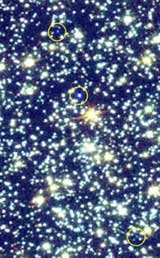Stars are promiscuous

Blue stragglers (ringed) are irresistable to others. <br>© NASA/Hubble <br>
Succession of relationships keeps heavenly bodies young
Astronomers have uncovered a scandalous degree of promiscuity in the cosmos. Clusters where stars gather more densely than usual are veritable hotbeds of partner-swapping. Some stars engage in half a dozen or so relationships during their lifetime1.
Star clusters range from loose groups of ten thousand or so stars to dense globular clusters of a million or more. They exist throughout galaxies like ours – from near the Galactic Centre to far outside the main galaxy body. In the centre of a globular cluster, star density can be more than 10 million times that around our own Sun.
Jarrod Hurley and Michael Shara, astronomers at the American Museum of Natural History in New York, have carried out state-of-the-art computer simulations of star clusters on new, purpose-built hardware called GRAPE-6.
GRAPE stands for ’gravity pipe’, a system devised in the mid-1990s to calculate the behaviour of thousands of stars moving under the influence of one another’s gravitational fields. In principle, every star influences every other one, so these calculations are very demanding.
Previous generations of GRAPE made many simple and unrealistic assumptions about the interactions between stars in clusters. GRAPE-6 follows the lives of individual stars in a population of 50,000 or so in great detail.
Clusters are so dense that two stars often become bound into binary systems. These pirouette around their common centre of mass. Some stars can even get trapped in groups of three or more. Hurley and Shara were surprised to find that these partnerships can form and break many times in a star’s life; so a star could have several different partners in close succession.
This promiscuity takes its toll. When they get together, stars can undergo profound character changes. In particular, they can coalesce or pull material from their partner to form larger, more massive stars.
Ménages and mergers
The researchers followed one particular star that began life as an object much like the Sun, but bound in a binary system with another star of about half its mass. First, this pair had a short-lived ménage-à-trois with a smaller star. They then got together with a triple system in a group of five.
After some dramatic exits from the group, the initial star, now aged about 3.5 billion, merged with another, doubling its mass. It then hooked up with another star of similar mass; they eventually coalesced to form a star with about four times the Sun’s mass. This found itself in another foursome, before merging again to make a still more massive star, which blew off much of its outer material and ended up, 4.3 billion years after the initial star formed, as a white dwarf.
This lurid case history “is not at all rare”, say Hurley and Shara. Cluster stars are constantly reinventing themselves.
A star such as the Sun gets gradually hotter, bluer and brighter as it ages. But astronomical observations have revealed that many stars in clusters show a different relationship between colour, brightness and age.
For example, globular clusters contain so-called blue straggler stars. These are much older than the Sun but look, judging from their colour and brightness, almost as young. Merging with or cannibalizing other stars may rejuvenate blue stragglers. Indeed, Hurley and Shara say that, once a star has become a blue straggler, it is irresistible to others: subsequent relationships “are almost inevitable”.
References
- Hurley, J. R. & Shara, M. M. The promiscuous nature of stars in clusters. Astrophysical Journal, 570, 184 – 189, (2002).
Media Contact
All latest news from the category: Physics and Astronomy
This area deals with the fundamental laws and building blocks of nature and how they interact, the properties and the behavior of matter, and research into space and time and their structures.
innovations-report provides in-depth reports and articles on subjects such as astrophysics, laser technologies, nuclear, quantum, particle and solid-state physics, nanotechnologies, planetary research and findings (Mars, Venus) and developments related to the Hubble Telescope.
Newest articles

Superradiant atoms could push the boundaries of how precisely time can be measured
Superradiant atoms can help us measure time more precisely than ever. In a new study, researchers from the University of Copenhagen present a new method for measuring the time interval,…

Ion thermoelectric conversion devices for near room temperature
The electrode sheet of the thermoelectric device consists of ionic hydrogel, which is sandwiched between the electrodes to form, and the Prussian blue on the electrode undergoes a redox reaction…

Zap Energy achieves 37-million-degree temperatures in a compact device
New publication reports record electron temperatures for a small-scale, sheared-flow-stabilized Z-pinch fusion device. In the nine decades since humans first produced fusion reactions, only a few fusion technologies have demonstrated…





















